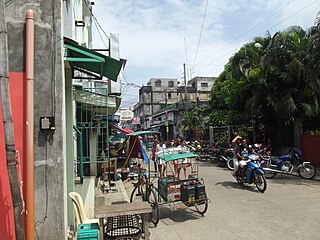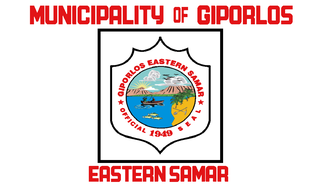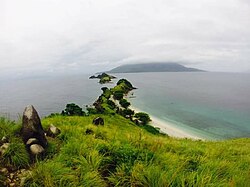
Biliran, officially the Province of Biliran, is an island province in the Philippines located in the Eastern Visayas region. Biliran is one of the country's smallest and newest provinces. Formerly a sub-province of Leyte, it became an independent province in 1992.

Albuera, officially the Municipality of Albuera, is a 3rd class municipality in the province of Leyte, Philippines. According to the 2020 census, it has a population of 47,151 people.

Cabucgayan, officially the Municipality of Cabucgayan, is a 5th class municipality in the province of Biliran, Philippines. According to the 2020 census, it has a population of 21,542 people. The town's populace predominantly speaks Waray.

Almeria, officially the Municipality of Almeria, is a 5th class municipality in the province of Biliran, Philippines. According to the 2020 census, it has a population of 17,954 people.

Biliran, officially the Municipality of Biliran, is a 5th class municipality in the province of Biliran, Philippines. According to the 2020 census, it has a population of 17,662 people. The town's populace predominantly speaks Waray.

Caibiran, officially the Municipality of Caibiran, is a 5th class municipality in the province of Biliran, Philippines. According to the 2020 census, it has a population of 24,167 people. The town's populace predominantly speak Waray language.

Culaba, officially the Municipality of Culaba, is a 5th class municipality in the province of Biliran, Philippines. According to the 2020 census, it has a population of 12,972 people.The town's populace predominantly speak Waray language.

Kawayan, officially the Municipality of Kawayan, is a 5th class municipality in the province of Biliran, Philippines. According to the 2020 census, it has a population of 20,455 people.

Naval, officially the Municipality of Naval, is a 2nd class municipality and capital of the province of Biliran, Philippines. According to the 2020 census, it has a population of 58,187 people.

Santo Niño, officially the Municipality of Santo Niño, is a 5th class municipality in the province of Samar, Philippines. According to the 2020 census, it has a population of 12,519 people.

Arteche, officially the Municipality of Arteche, is a 3rd class municipality in the province of Eastern Samar, Philippines. According to the 2020 census, it has a population of 16,360 people.

Can-avid, officially the Municipality of Can-avid, is a 4th class municipality in the province of Eastern Samar, Philippines. According to the 2020 census, it has a population of 21,682 people.

General MacArthur, officially the Municipality of General MacArthur, is a 5th class municipality in the province of Eastern Samar, Philippines. According to the 2020 census, it has a population of 14,411 people.

Giporlos, officially the Municipality of Giporlos, is a 5th class municipality in the province of Eastern Samar, Philippines. According to the 2020 census, it has a population of 13,117 people.

Jipapad, officially the Municipality of Jipapad, is a 5th class municipality in the province of Eastern Samar, Philippines. According to the 2020 census, it has a population of 8,439 people.

Maslog, officially the Municipality of Maslog, is a 5th class municipality in the province of Eastern Samar, Philippines. According to the 2020 census, it has a population of 5,463 people.

Sulat, officially the Municipality of Sulat, is a 4th class municipality in the province of Eastern Samar, Philippines. According to the 2020 census, it has a population of 15,758 people.

Hindang, officially the Municipality of Hindang, is a 5th class municipality in the province of Leyte, Philippines. According to the 2020 census, it has a population of 20,849 people.

Isabel, officially the Municipality of Isabel, is a 1st class municipality in the province of Leyte, Philippines. According to the 2020 census, it has a population of 46,781 people.

Tabontabon, officially the Municipality of Tabontabon, is a 5th class municipality in the province of Leyte, Philippines. According to the 2020 census, it has a population of 11,902 people.
























